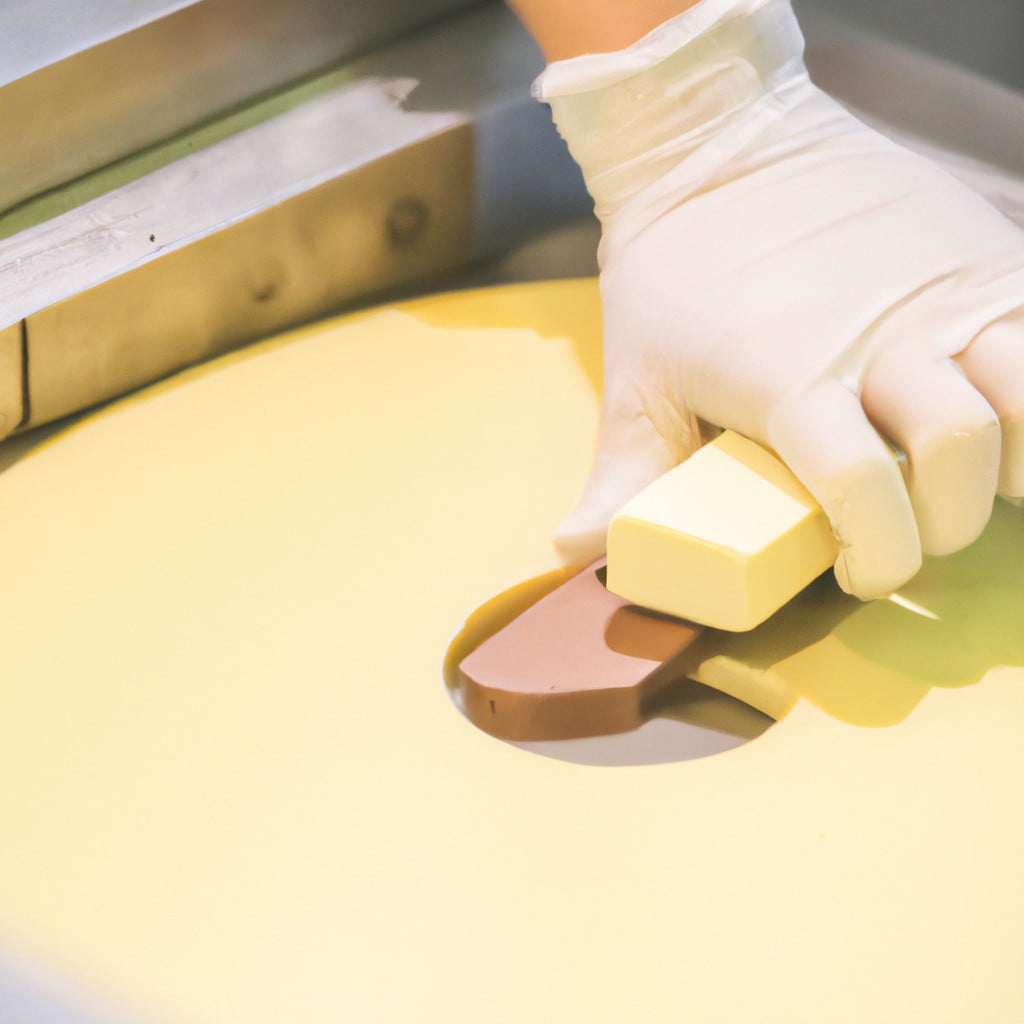This article offers a detailed step-by-step process on how white chocolate is made from raw cocoa beans to the final delicious product.
Key takeaways:
- White chocolate ingredients: cocoa butter, milk solids, sugar, lecithin.
- Process: extract cocoa butter, blend with milk solids and sugar, add lecithin, conch, temper, mold.
- Quality considerations: select premium cocoa butter, high-quality milk powder, refined sweeteners.
- Comparing white, milk, and dark chocolate: white lacks cocoa solids, milk is creamier, dark is less sweet.
- Health aspects: contains cocoa butter, high in sugar and calories.
Inside
White Chocolate Ingredients

The core components of white chocolate include cocoa butter, milk solids or powder, and sugar.
Cocoa butter, the fat extracted from the cocoa bean, imparts a smooth texture and is responsible for the chocolate’s melt-in-your-mouth quality.
Milk solids add creaminess, while sugar enhances sweetness.
Lecithin, often derived from soy, acts as an emulsifier, ensuring a stable blend of ingredients.
Vanillin or vanilla extracts may be incorporated for flavor.
Unlike milk or dark varieties, white chocolate contains no cocoa solids, hence its pale color and distinct taste profile.
White Chocolate Production Steps
Cocoa butter, milk solids, sugar, and lecithin are the core components used in making white chocolate. Production begins by extracting cocoa butter from the cacao bean. This butter provides the fat needed for a smooth texture.
Next, milk solids are blended with the cocoa butter. The type of milk used varies by manufacturer but often includes milk powder or condensed milk. This mixture is then combined with sugar to add sweetness.
Lecithin, an emulsifier, typically sourced from soy, is added to the mix to ensure a homogenous blend and to improve the flow of the chocolate during the manufacturing process.
The ingredients are thoroughly mixed together in a process known as conching where they are continuously ground and heated. Conching can last from a few hours to several days, and it’s crucial for developing flavor and achieving a velvety texture.
After conching, the chocolate is tempered, a precise process of heating and cooling, which stabilizes the cocoa butter crystals. Proper tempering imparts a glossy finish and a firm snap, characteristic of high-quality white chocolate.
Finally, the mixture is poured into molds to set. Once solidified, the chocolate is demolded, packaged, and ready for enjoyment.
Quality Considerations in White Chocolate Making
Ensuring the quality of white chocolate starts with the selection of premium cocoa butter, which should possess a smooth, mellow flavor without any off-notes. The cocoa butter’s purity is crucial, as any impurities can negatively affect the final product’s taste and texture.
The quality of the milk powder also plays a significant role. High-quality milk powder contributes to a creamy taste and a velvety mouthfeel. Consistency in the milk powder’s fat content is essential for maintaining the white chocolate’s luxurious texture.
Sweeteners must be well-refined; granulated sugars are typically preferred for their ability to dissolve thoroughly, creating a consistent sweetness without a gritty texture.
The emulsifier, usually lecithin, must be used judiciously to ensure a stable emulsion without impacting the flavor profile.
Vanilla is often added to enhance the flavor profile of white chocolate. Using pure vanilla extract can make a difference in the depth of flavor, elevating the overall taste experience.
The tempering process is critical for achieving the desired snap and sheen. Careful control of the temperature during this process develops a proper crystalline structure, resulting in chocolate that melts smoothly on the palate.
Storage conditions are important as any exposure to high temperatures or humidity can lead to fat bloom, affecting both appearance and texture.
By managing all these factors attentively, manufacturers can produce white chocolate that delights consumers with its creamy texture and balanced sweetness.
Comparing White, Milk, and Dark Chocolate
Differences in chocolate types arise from their unique components. White chocolate contains cocoa butter but lacks cocoa solids found in milk and dark varieties, thus it doesn’t exhibit a deep chocolate flavor. Milk chocolate, enriched with milk solids and cocoa, offers a creamy taste and smoother texture.
Dark chocolate, characterized by a high cocoa solid content, provides a robust flavor and less sweetness compared to its counterparts, often making it a choice for those seeking a less sugary option.
Each variety also has different melting points due to their distinct fat contents, with white chocolate melting at a slightly lower temperature due to its higher cocoa butter ratio. This factor is crucial when considering chocolate for cooking and baking purposes.
Nutritional profiles vary, with dark chocolate typically containing more antioxidants and less sugar than milk or white chocolate. This has sparked a trend towards dark chocolate for health-conscious consumers, although moderation is key in enjoying any chocolate as part of a balanced diet.
Health Aspects of White Chocolate
White chocolate, while not containing cocoa solids, still offers a few health benefits due to its cocoa butter content, which contains stearic acid, a saturated fat that may have a neutral impact on cholesterol.
However, it’s also high in sugar and calories, which could contribute to weight gain if consumed in excess.
Unlike dark chocolate, it lacks significant amounts of antioxidants and stimulants like caffeine and theobromine.
Consequently, white chocolate should be enjoyed in moderation as part of a balanced diet.
It also provides trace amounts of calcium from the milk products used in its production.
Always check the label for real cocoa butter to ensure the authenticity of the white chocolate for its potential benefits.




